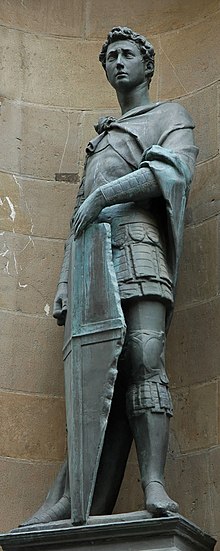Saint George in devotions, traditions and prayers
Since the Middle Ages, the story of the life of Saint George, both as fact and legend, has come to symbolize the victory of good over evil, and become part of local Christian traditions, festivals and celebrations that continue to date.Daniel Papebroch, Jean Bolland and Henschen provided a good account of the life of Saint George in Acta Sanctorum and it inspired other scholars to dispense with Medieval myths and perform detailed studies.[8] After multiple attempts by hagiographers, the time of Saint George's life was firmly established in the Bibliotheca Hagiographica Graeca as being during the reign of the Roman Emperor Diocletian in the late third century, rather than the mythical King Dadianus.A document found in the Vatican was signed by a witness Pascrates on April 23, which had previously been reported as the date of Saint George's execution, and had since become his feast day.In the sixth century Saint George as the Martyr of Cappadocia began to grow in popularity among Greek Egyptians and the devotion spread to other parts of Europe.But by the time of the Muslim conquest in the seventh century, a large three-aisled basilica existed, with the martyr's tomb located beneath the main altar.The Church of Saint George at Mangana, now partially excavated, was built by the bishop of Euchaita in the early eleventh century under Constantine IX at great expense and had truly imposing dimensions for any medieval structure.He was portrayed in art as a protector and as a symbol of sacrifice, and the interplay of battle cries, prayers, artistic depictions and the construction of Churches in his honor led to increased devotion.[29] The invocation of Saint George as a protector during the Middle Ages is well exemplified by the conduct of the soldiers participating in the Battle of Iconium in 1190, during the Third Crusade.As Frederick I Barbarossa marched through Anatolia, his troops were involved in group prayer and the bishops would hold camp-wide religious rites for them to strengthen their faith and morale.During the battle on May 14, the priests and bishops (at the risk of injury or death) went to the front, among the troops, to pray, wearing their white stoles that made them obvious targets for the Muslims.Here, the pleas for help to Saint George and the ensuing victory led to donations by the soldiers for the construction of the Church of San Giorgio in Siena and an annual festival that grew so large that it had to be moved to a larger location.[33] During the eleventh century Crusades many of the Normans under Robert Curthose, the Duke of Normandy and son of William the Conqueror, took Saint George as their patron.The association of Saint George with the dragon was not attested to until the twelfth century version of Miracula Sancti Georgii (Codex Romanus Angelicus 46, pt.[43][44][45] The similarities extend to the visual representations, and many artistic portrayals of Saint George slaying the dragon have distinct counterparts in the renderings of Perseus and Andromeda.[48] The Swedish regent Sten Sture the Elder attributed his victory over King Christian I of Denmark in the 1471 Battle of Brunkeberg to the intercession of Saint George, and in the aftermath commissioned a statue of Saint George and the Dragon carved by the Lübeck sculptor Bernt Notke for the Storkyrkan church in Stockholm, as an obvious allegory of Sture's battle against Christian.Syriac Christians (who arrived first) and the Portuguese brought the legend of the pious and brave Saint George to Kerala in Southern India and statues to honor him were erected.In Stockholm Cathedral, an exceptionally lifelike monumental wooden statue of Saint George was erected by the fifteenth century Lübeck carver Bernt Notke, an exact copy of which can be found in his hometown in the St. Catherine Church.[62] The story of Saint George slaying the dragon is interpreted allegorically, representing the triumph of good over evil and the protection of the faithful from harm.[62] Along with the construction of churches, creation of art and spread of legends, a number of genuine devotions and prayers to Saint George developed over the ages among Christians.[64] The Prayer to Saint George directly refers to the courage it took for the saint to confess his Christianity before opposing authority:[65] Almighty God, who gave to your servant George boldness to Confess the Name of our Savior Jesus Christ before the rulers of this world, and courage to die for this faith: Grant that we may always be ready to give a reason for the hope that is in us, and to suffer gladly for the sake of our Lord Jesus Christ; who lives and reigns with you and the Holy Spirit, one God, for ever and ever.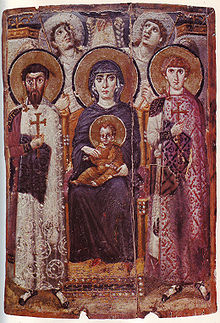
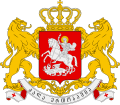

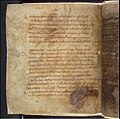


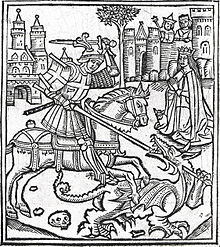

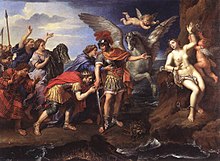
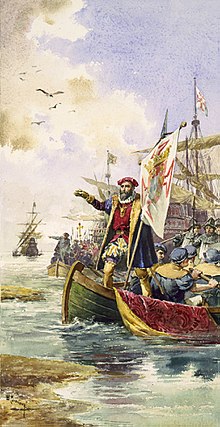

Tel AvivSaint GeorgesaintsMiddle AgesVirgin Mary and ChildSt. TheodoreSaint Catherine's MonasteryAloysius LippomaniBergamoJesuitBollandistsDaniel PapebrochJean BollandActa SanctorumBibliotheca Hagiographica GraecaDiocletianCappadocianPalestineDiocletianic PersecutionGeorgiaSaint NinoCappadociaancient IberiaRoman EmpireBlack SeaCaspian SeaMcxetaSvetitskhoveli CathedralKings of IberiaChristVirgin MarySan Giorgio in VelabroByzantineFlavius BelisariusPorta San SebastianoSakkaiaPope Leo IIPope ZachariasMuslim conquestReichenau monastic islandLake ConstanceGeorgsliedSchwazEuchaitaConstantine IXStaraya LadogaTheodore of AmaseaSt Mark's BasilicaHermann WislicenusBattle of IconiumThird CrusadeFrederick I BarbarossaAnatoliaSan Giorgio, SienaBattle of MontapertiPentecostIconiumChurch of San Giorgiostandard-bearerAlexander BarclayCrusadesNormansRobert CurthoseDuke of NormandyWilliam the ConquerorBritish MuseumEdmund the MartyrEdward the ConfessorRichard the LionheartEdward IIIstained glasscrusadersLisbonSaint ConstableBattle of AljubarrotaJohn I of PortugalTintorettoNational GalleryiconographySaint George and the DragonJacobus de VoragineThe Golden LegendSchonberg mountainLiechtensteinPerseusAndromedaPierre MignardLouvreGreek mythologyminstrelsSten Sture the ElderChristian IBattle of BrunkebergLübeckBernt NotkeStorkyrkanVasco da GammaSyriacPortugueseKeralaidolatrousKottayamEdathuaDonatelloFlorenceFlorentine artStockholm CathedralSt. Catherine Churchcoat of armsFerraraValaisBavariaDiogo CãoRiver CongoBrazilMayflowerSt. George's United Methodist ChurchPhiladelphiaSt. George, Staten IslandSt. George's Cathedral, PerthSt. George's Cathedral, Cape TownSaint George's Church, SingaporeChristian influence on Druze faithChristian saintsElijahMount Lebanon

